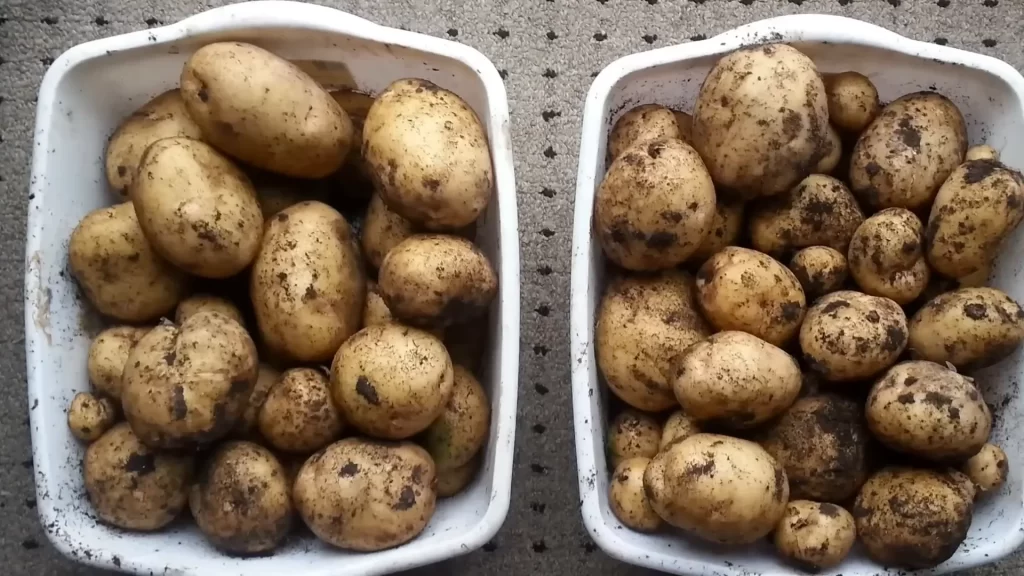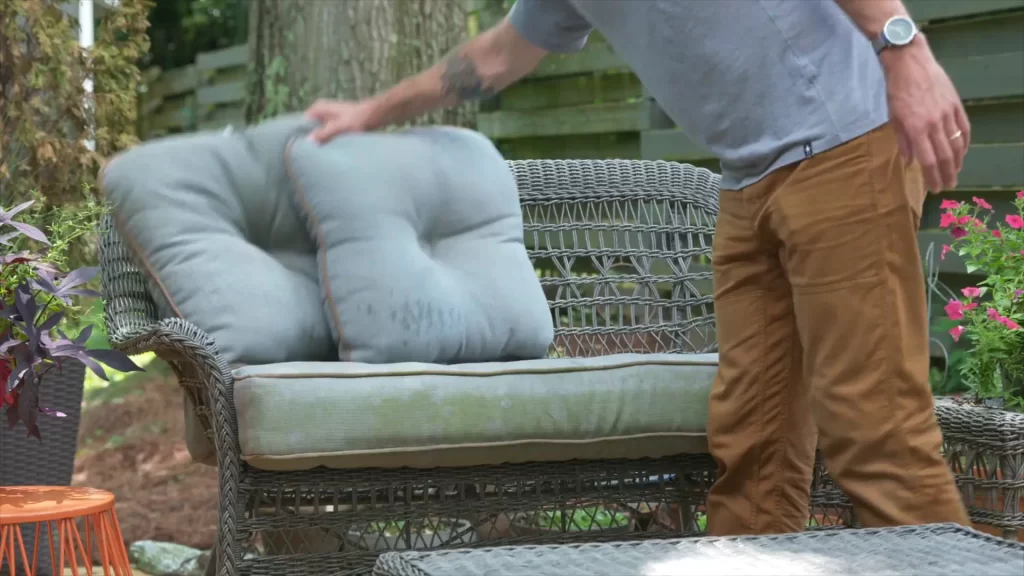
To keep your succulents thriving, always guarantee their soil is completely dry down to 1.25 inches before you water them using the “soak and dry” method. This technique, which involves thoroughly drenching the soil and allowing excess water to drain, is one of the best practices when learning how to care for succulents. Ensure your succulents receive about six hours of indirect sunlight daily, as direct sunlight can cause leaf scorching.
For optimal growth, choose a draining soil mix, ideally made of 60% potting soil and 40% coarse material such as perlite. During the growing season, lightly fertilize your plants with a half-strength balanced fertilizer to meet their nutrient needs. To maintain their health, regularly inspect for pests and signs of distress. As you explore how to care for succulents, you’ll discover more tailored tips to help them thrive in your unique environment.
Understanding Succulent Water Needs
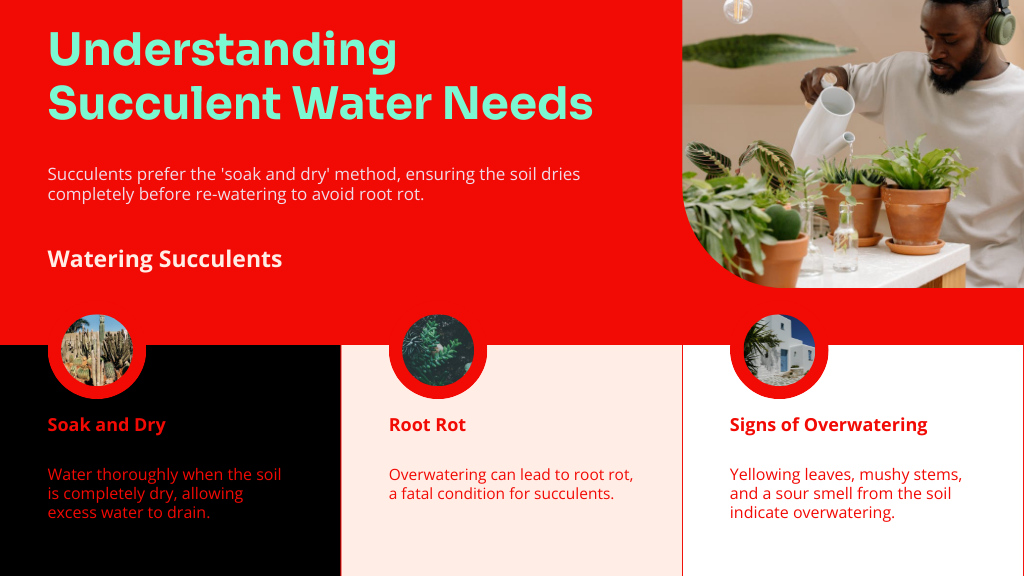
When caring for succulents, it’s vital to get the watering right. Understanding when and how much water your succulents need can be the difference between thriving and merely surviving, especially during the winter months. Start by checking the soil: it should be completely dry down to about 1.25 inches before you even think about watering again. This method helps prevent the dreaded root rot.
You’ll want to use the “soak and dry” method. When the soil is dry, water thoroughly until you see excess water drain out from the bottom. This makes sure every part of the soil gets moisture, which is essential for healthy roots. However, don’t let your plant sit in standing water. During spring and summer, increase your watering frequency as these are the growing months. But come fall and winter, cut back considerably since your succulents will be dormant.
Be vigilant for signs of overwatering. If you notice yellowing leaves, mushy stems, or a sour smell from the soil, it’s time to take action. These symptoms suggest too much moisture, which can be detrimental to healthy succulents. Reducing the water and letting the soil dry out may just save your plant. Remember, succulents are tough; they’ve adapted to thrive with less, so when in doubt, it’s usually safer to under-water rather than over-water.
Importance of Proper Sunlight
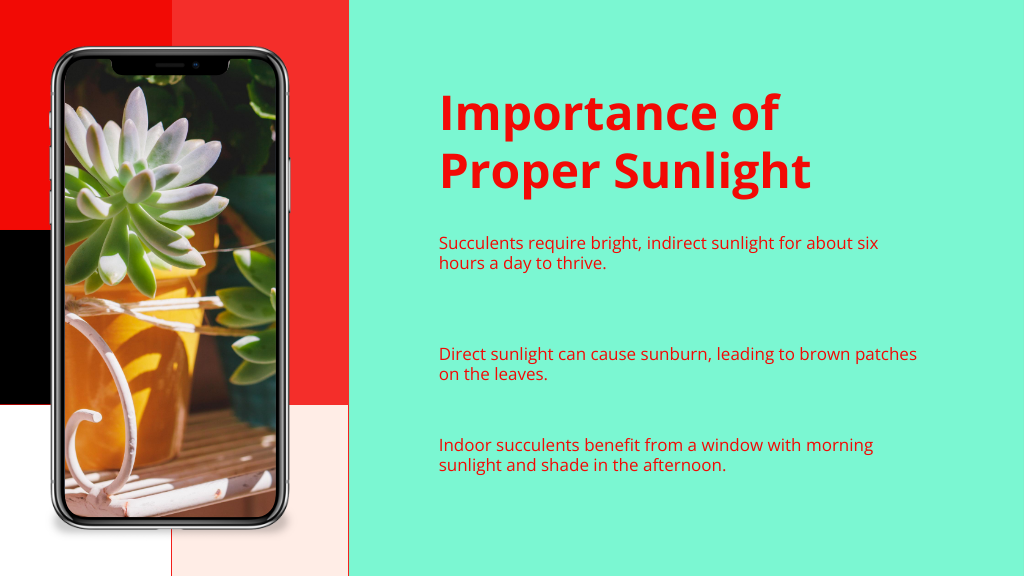
Getting the right amount of sunlight is essential for your succulents to flourish. You’ll need to guarantee they’re exposed to bright, indirect light for about six hours a day to mimic their natural arid conditions without causing damage. We’ll explore ideal sunlight conditions, provide tips on sun exposure, and discuss how to prevent sun damage to keep your plants healthy and vibrant.
Ideal Sunlight Conditions
Succulents thrive under specific lighting conditions, needing about 6 hours of bright, indirect sunlight each day. To master how to take care of succulents, it’s crucial to understand the role of light. This not only promotes healthy growth This not only preserves the vibrant colors and unique shapes of your plants but also ensures they remain healthy succulents.
Here are three key points to remember:
- Avoid direct sunlight to prevent your houseplant from getting scorched.: While they need bright light, direct sunlight can harm your succulents. It can cause sunburn, where leaves develop brown patches and may become dry or crispy.
- Choose the Right Location: If you’re growing succulents indoors, a spot near a window that receives ample morning sunlight and shade in the afternoon is ideal. This mimics their natural environment and prevents the harsh midday sun from damaging them.
- Observe and Adjust: Pay attention to your plants’ appearance. Signs like stretching toward the light or pale, elongated growth indicate the need for more sunlight. Rotate them regularly to guarantee all sides receive light evenly, preventing lopsided growth.
Sun Exposure Tips
Proper sunlight is essential for your succulents to flourish, requiring about six hours of bright, indirect light each day. When caring for succulent plants, it’s vital to avoid placing them where the sun can scorch their leaves. Instead, use sheer curtains to filter intense light or position them in areas with dappled sunlight. This approach protects them from direct sunlight while guaranteeing they receive the light they need for happy and healthy succulents.
Low-light succulents, like Haworthia and ZZ plants, thrive in spaces with limited sunlight, making them perfect for indoor settings where natural light is scarce. Even if you’re growing more sun-loving varieties, remember to water succulents appropriately to keep them healthy. rotate your succulents every couple of weeks. This prevents uneven growth and guarantees all sides of your plant get equal exposure to light.
Preventing Sun Damage
To protect your succulents from the harsh effects of direct sunlight, it’s crucial to manage their exposure carefully. Succulents need about 6 hours of bright, indirect sunlight daily to thrive. Too much direct sun can cause leaf scorching, resulting in unsightly beige or brown patches.
Here are three key steps to prevent sun damage while caring for succulents indoors:
- Acclimate your indoor plants gradually for better growth.: When you bring new succulents home or move them to a sunnier spot, gradually increase their exposure to full sun. Start by placing them in a location where they receive filtered sunlight, and slowly adapt them over several weeks.
- Choose Appropriate Varieties: Opt for low-light succulents like Haworthia or ZZ plants if your indoor spaces don’t get much direct sunlight. These varieties are more tolerant of shaded environments and will thrive without the intense rays.
- Rotate Regularly: Turn your succulents periodically to make certain all sides receive equal light. This helps prevent the plants from growing lopsided and protects them from getting sunburned on one side.
Selecting the Right Soil
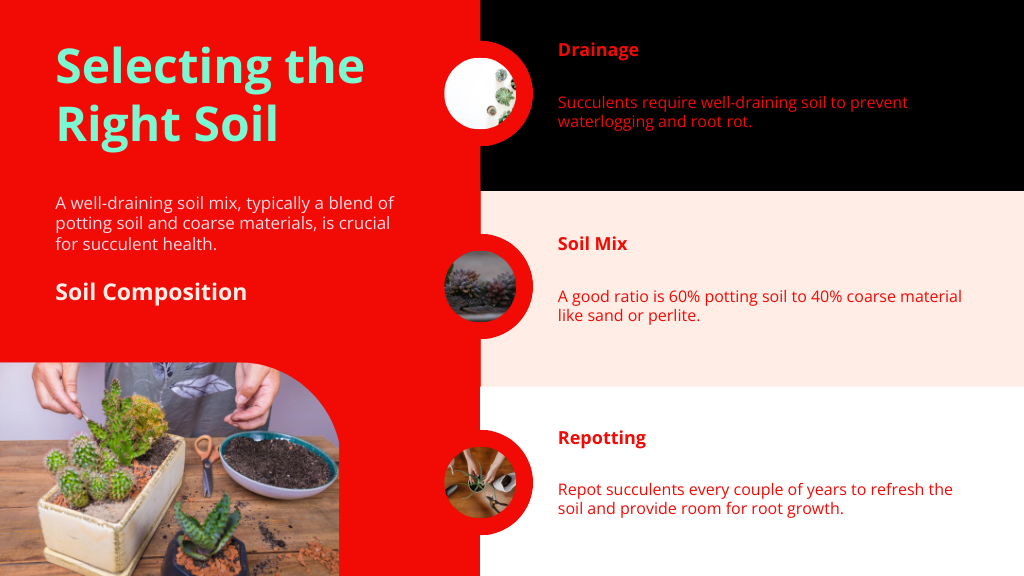
Choosing the right soil Regular watering is essential for the health of your succulents, as happy and healthy succulents thrive with proper care. poor drainage can swiftly lead to root rot. Succulent care starts with making sure that your plants have the ideal soil composition. Regular potting soil won’t cut it because it often retains too much moisture. Instead, you’ll want to mix your own or opt for a cactus-specific blend.
A good rule of thumb is to use a mix that consists of 60% potting soil to 40% coarse material, like sand or perlite, to ensure happy and healthy succulents. This ratio guarantees that your succulents and cacti thrive in their environment. excellent drainage, preventing water from lingering around the roots, which can be fatal.
If you’re up for a bit of DIY, you can create a custom mix using equal parts of potting soil, sand, and pumice to give your succulents a supportive environment. This blend not only enhances drainage but also maintains the slight acidity, with a pH of about 6.0 to 7.0, that succulents prefer.
Don’t forget to repot your succulents every couple of years. This refreshes the soil, replenishes nutrients, and provides roots ample space to grow. Always check for drainage holes in your pots to guarantee excess water can escape, safeguarding your plants from the dangers of overwatering.
Benefits of Adequate Drainage
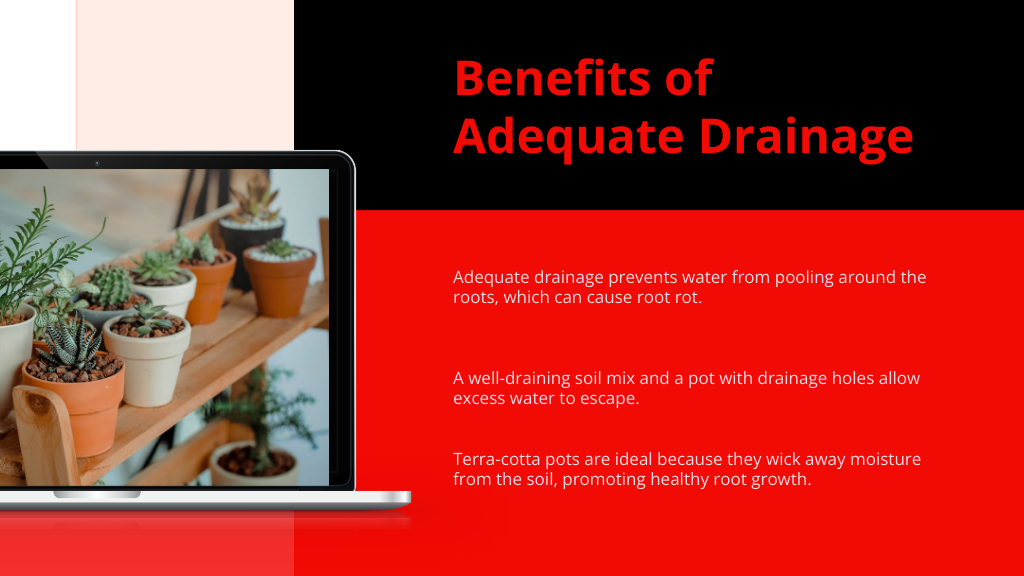
Adequate drainage isn’t just helpful; it’s essential for succulent health. When you’re diving into succulent plant care indoors, understanding the role of proper drainage can make all the difference. Here’s why guaranteeing your succulents have the right drainage setup is non-negotiable:
1. Prevents Root Rot: Succulents store water in their leaves and thrive in dry conditions. Without adequate drainage, water pools around the roots, creating an environment ripe for root rot and other moisture-related diseases. Guaranteeing your pot has drainage holes allows excess water to escape instead of accumulating at the base.
2. Promotes Healthy Root Growth: A well-draining soil mix and a pot with drainage holes support healthy root development. Roots need air as much as they need water, and a soggy soil environment can smother and kill them. Terra-cotta pots are particularly effective as they wick away moisture from the soil, making them ideal for low-maintenance houseplants.
3. Maintains Soil Integrity: Using a soil mix with perlite or sand not only enhances drainage but also keeps the soil structure intact. Regular checks on the drainage system, including both the soil and pot condition, guarantee that your succulents aren’t sitting in water.
Timing and Techniques for Fertilization
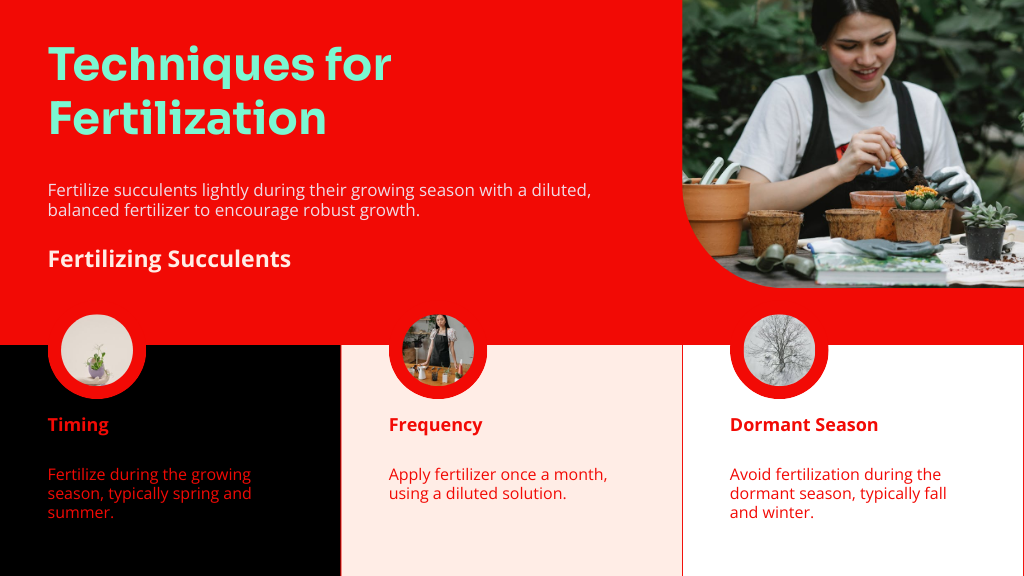
After guaranteeing your succulents have proper drainage, it’s also important to contemplate their nutritional needs. Focusing on timing and techniques for fertilization is essential in succulent care tips. You should fertilize your succulents lightly during their growing season, which typically spans spring and summer.
Use a diluted, balanced fertilizer about once a month to encourage robust growth. It’s critical to follow the instructions on the fertilizer package but consider halving the recommended amount. Over-fertilizing can actually weaken your plants, leading to nutrient burn.
During the During the During the dormant months, it is crucial to reduce watering for your indoor succulent., it is crucial to reduce watering for your indoor succulent. of fall and winter, hold off on fertilizing. Succulents slow down their growth in this period and don’t require additional nutrients. Opting for a balanced approach can give your succulents the nutrients they need. organic fertilization methods, such as fish emulsion or compost tea, can be beneficial. These natural options provide important nutrients without the risk of harmful chemical buildup.
Additionally, renewing the soil fertility every couple of years supports nutrient availability and complements your scheduled fertilization efforts for happy and healthy succulents. This practice guarantees that your succulents remain healthy and continue to thrive.
Identifying and Solving Common Problems
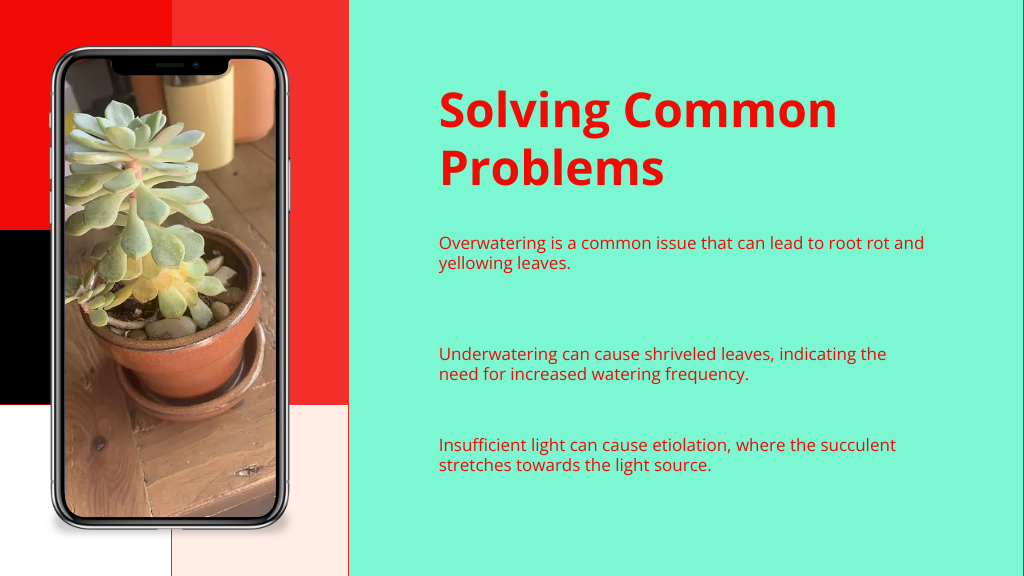
While succulents are hardy, identifying and addressing common issues promptly is key to maintaining their health. When you’re caring for a succulent plant indoors, it’s essential to be vigilant about their unique needs.
Here are some common problems you might face and how to solve them:
- Overwatering is a common mistake that can harm your succulents and cacti.: If you notice yellowing leaves, it’s a sign you might be overwatering. Make sure the top 1.25 inches of soil is completely dry before watering again. This helps prevent root rot, a common issue in succulents that can lead to plant death if not addressed.
- Underwatering: On the flip side, shriveled leaves often indicate underwatering. Check the soil moisture and adjust your watering frequency. Succulents thrive in dry conditions but do need water to sustain their health.
- Insufficient Light: Etiolation, or stretching, occurs when your succulent isn’t getting enough light. Move your plant to a brighter location or consider using artificial lighting to mimic natural light conditions.
Regularly inspect your succulents and cacti for pests like mealybugs and aphids to keep your indoor plants thriving. mealybugs and spider mitesIf you find pests, treat infestations with 70% isopropyl alcohol to give your succulents a fighting chance. Also, adjust their exposure to direct sunlight to prevent sunburn, which shows as brown patches or scorched leaves.
Frequently Asked Questions
What Is the Trick to Keeping Succulents Alive?
To keep your succulents alive, you’ll need to water them only when the soil’s dry, provide lots of indirect light and use well-draining soil. Don’t forget to check for pests regularly!
What Makes Succulents Happy?
You’ll make your succulents happy by giving them bright, indirect sunlight, well-draining soil, and minimal water. Rotate them regularly and feed lightly during growing seasons to promote vibrant growth and prevent issues.
Why Do Succulent Leaves Fall Off?
Succulent leaves fall off because you might be overwatering or underwatering them. They’re also sensitive to temperature changes and pests, which can affect the health of your houseplant. Make sure they’re getting enough light to avoid stretching and weakening.
Should I Water or Spray Succulents?
You should water your succulents, not spray them. Use the soak-and-dry method, ensuring the soil is completely dry before watering again to prevent root rot and keep your plants healthy.
Conclusion
You’re now equipped to nurture your succulents like a pro! Remember, it’s all about the right balance: water carefully, provide ample sunlight, and choose the right soil and drainage. Don’t forget to fertilize at the right times. If you notice any issues, tackle them quickly to keep your plants thriving. Embrace these tips, and watch your succulents grow beautifully. Here’s to starting your journey as a savvy succulent caregiver!
